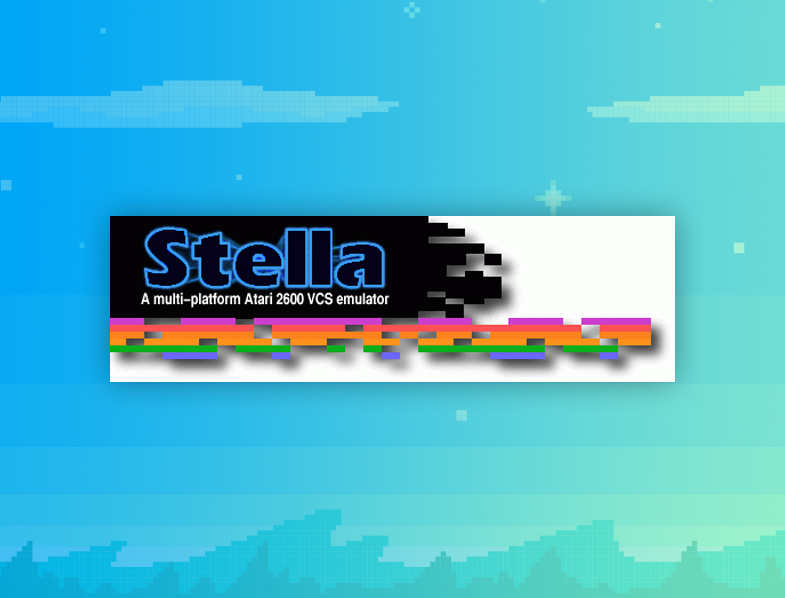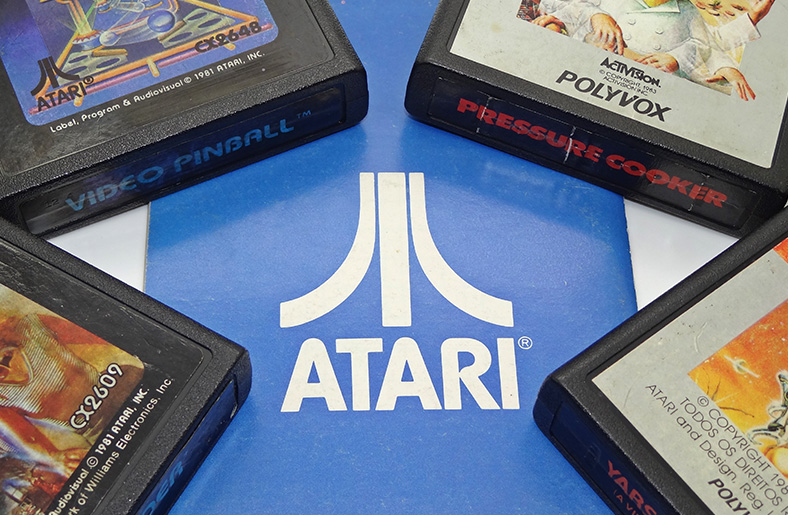The Atari 2600 is credited as the console that popularized ROM cartridges containing game codes. It also is seen as the purveyor of video games with games like Space Invaders, Pac-Man, and the one that caused the video game crash of 1983, E.T. Extra-Terrestrial.
Below are the best emulators for this fundamental force of the video game industry, the Atari 2600.
1. Stella

Stella is the best standalone emulator for the Atari 2600 Video Computer System (VCS). It can run on all desktop hardware. It is also a Retroarch core, so you can play your Atari 2600 games on hardware where this emulator is not available as a standalone.
Stella is a high-speed emulator without sacrificing accuracy. It is a cycle-based emulator. Stella also supports high-quality sound emulation, which also includes stereo sound support and dynamic sound resampling.
Aside from software emulation, Stella can also emulate the hardware joystick, paddles, driving, CBS Booster Grip, as well as the Sega Genesis and Quadtri controllers, using a keyboard, joysticks, and even a mouse. The Atari keyboard can also be emulated using your computer’s keyboard, this feature is not really surprising to be fair.
It also has gamepad support for the most common controller types. High-score saving is also available as this is mostly the foundational feature of this era. Save state is also available and that should be expected in every recommended emulator. For the emulator nerds, there is an extensive debugger, including static analysis with the Distella disassembler and dynamic analysis at runtime by tracking code/graphics/data sections, and generation of DASM-compatible disassembly files.
The most important feature of this emulator is its emulation of CRT TV. Stella uses Blargg filtering with presets for common TV outputs like Composite, S-Video, and RGB. Gamers can also customize the settings to their hearts’ content like contrast, brightness, saturation, and gamma.
Pros
- Accurate
- In active development
- Lots of features especially the filtering
Cons
- No standalone port for ARM / mobile devices
Download from the Official Website (All Platforms)
2. MAME

Multiple Arcade Machine Emulator (MAME) is a C++-based multi-platform, open-source, multi-system emulator. It differs from Retroarch because Retroarch is not an emulator while MAME is. MAME is enormous, supporting thousands of machines and ROM sets; however, what is supported is not always what is playable; your mileage may vary. If you dislike MAME’s default interface, there are numerous alternative frontends available like the aforementioned Retroarch. Retroarch is the third recommendation in this list although technically it is not an emulator.
MAME’s main goal is to preserve decades of arcade, computer, and console history. As technology advances, MAME keeps these critical retro systems from being lost and forgotten.
While MAME’s Atari 2600 is cycle-based it also supports plugins. These plugins are mostly functionality based and not hacks to improve performance and/or accuracy. The Atari 2600 is not that hard to emulate anymore due to its age, so there is no use to have plugins for that specific need.
Pros
- Accurate
- In (very) active development
- Fast
Cons
- No standalone port for ARM / mobile devices
Download from the Official Website (All Platforms)
3. Retroarch

Retroarch is a multi-platform front-end, not an emulator in and of itself. It is a fast and lightweight front end that can run on any hardware. What makes Retroarch so better compared to using standalone emulators is that you can swap systems within the program and there is no need to close and open programs. The settings are also saved across this platform. This is especially helpful to really old systems like Atari 2600 and the Sega systems pre-Dreamcast.
Retroarch’s options and tweaks are fantastic. The user interface may be adjusted to meet the size of the screen, whether it’s tiny like a smartphone, or huge like a TV. It may be exhausting to search for those alternatives, but they do exist. Because the performance of the cores is dependent on the power of your hardware, the experience should be consistent in terms of UI regardless of your hardware.
Retroarch’s main advantage is its ability to eliminate input lag. However, for Atari 2600 emulation, this is not useful since all hardware from this decade and the decade before it can run games from that console without needing input lag reduction from Retroarch.
Another advantage of Retroarch is the achievements acquired through Retroachievements. Those who are looking to emulate Atari 2600 since it is their childhood or teenage system will have the high score-saving feature enough. It would not hurt to have Retroachievements too if that is your jam.
It is up to you which core you use to emulate Atari 2600 games, although the Stella core is highly recommended for its maturity.
Pros
- Highly configurable
- Miraculous input lag reduction (although not necessarily needed for playing Atari 2600 games)
- Available in a surprisingly broad range of gaming hardware including the PSP and the 3DS
Cons
- Not beginner friendly
- Menu digging
Download from the Official Website (All Platforms)
4. Javatari

If in the year 2023 you still have no hardware powerful enough to run any of this Atari 2600 emulator or frontend, Javatari is the only option to play the system. This is also the way to play Atari 2600 games on iOS devices since it is only using your browser. Yes, this is how ancient the Atari 2600 system is that it can run on browsers. Better watch out in the near future as Apple will open their systems to third-party stores. Expect emulators like Atari 2600 to be available for iOS.
Javatari runs on Chrome, Firefox, and Safari on desktop hardware as well as their iOS and Android counterparts. The touch controls, if you choose to play on your smartphone or tablet, can be customized and even has haptic feedback. You can also install Javatari as a WebApp so you can run it offline on a desktop or mobile. Common emulator features like adjustable speed, savestates, and screen capture are included. Advance features like debugger and multiplayer through Netplay! is also available.
Pros
- Accurate
- In active development
- Lots of features including multiplayer
- Can be used as WebApp
Cons
- No standalone port for any device
Open on your browser (All Platforms)



